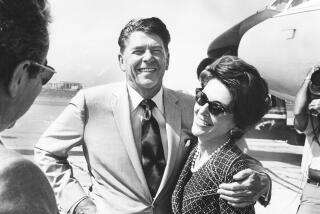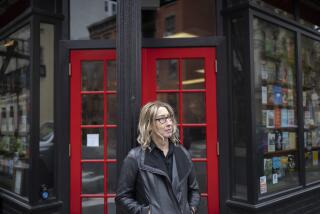Reaganology
SIMI VALLEY — On a recent weekday at the Ronald Reagan Presidential Library and Museum, fifth-grader Edwin Mendoza’s eyes were opened to the 19th-century world of Queen Victoria.
At the same time, J.J. Albert, a 22-year-old Cal Lutheran University senior, was poring over once-private documents on the 40th president’s immigration policy for his final project.
And author John Campbell, visiting from London, worked on uncovering historical morsels to use in the second volume of his biography on former Prime Minister Margaret Thatcher.
Since the library opened a decade ago, it has launched dozens of educational outreach programs, targeting everyone from youngsters studying the American Revolution to graduate students looking at how the Professional Air Traffic Controllers Organization strike affected labor policy in the early 1980s.
With 50 million pages--10 million of which have so far been made available for research--the Reagan facility holds more documents than any of the other nine presidential libraries operated by the National Archives and Records Administration. It has attracted about 160,000 visitors and 200 researchers each year since it opened in 1991, according to annual reports from the federal agency.
And officials hope to draw even more in the years ahead, with a goal to double the number of schoolchildren--from 25,000 to 50,000--who tour the museum’s exhibits each year and expand partnerships with universities and high schools to take advantage of treasures hidden deep in the library’s archives.
“We have endless opportunity to engage people, from first-graders to PhD students--all in our backyard,” said R. Duke Blackwood, the library’s director and a former fund-raiser for USC.
A large part of that opportunity comes from the Presidential Learning Center--a joint operation between the museum and the Ronald Reagan Presidential Foundation. Last fall, the learning center kicked off what officials say will become an annual workshop to introduce high school teachers to the library’s research opportunities.
Since then, a handful of high school students have come in to use the documents and audio-visual resources for extra-credit assignments, said Lou Anne Missildine, the library’s education specialist. Later this year, an advanced placement history class from Santa Susana High School in Simi Valley will spend the day in the research room.
“We want to reach out to them because this primary-source material is so valuable,” she said. “If it lights a fire under any of them to become historians or to do further research here, that’s what we want to encourage.”
Albert, a social sciences major at Cal Lutheran, said he wishes he would have had that opportunity earlier in his academic career. Though he knew the library was fewer than five miles away, he said he was oblivious to the access he had to its research materials until he enrolled in Michaela Reaves’ class on the American presidency.
Forging Close Ties to Area Universities
After sifting through memos, notes and speeches written by White House attorneys and other staff members, Albert said he is more knowledgeable about how the policies were formulated and about the president’s decision-making process.
“It’s a lot better than studying out of books in a dorm room,” he said.
Reaves’ course, required for history and social science majors at the university, includes an introduction to the archives at the beginning of the semester and requires turning in either a research paper or a week’s worth of lesson plans at the end of the term in May.
“For my students it’s such an enrichment to have the library here,” Reaves said. “It’s really enhanced what we can do.”
She also makes a point to take advantage of the authors and scholars who come from around the world to use the library’s research room.
Campbell, who said his is the first historical biography of Thatcher, has spent two weeks gathering quotes from personal letters she and Reagan wrote to each other while both were in office. Toward the end of his stay, he spoke to Reaves’ class, sharing what he found with her students.
“Reagan is very keen to call her ‘Margaret’ in these formal cables between governments, as if he’s got her by the elbow,” Campbell said. “At the moment that’s what I’ve found quite interesting.”
Campbell said he spent a week at the libraries of the other two presidents Thatcher worked with--Jimmy Carter and George Bush--but has found the most useful information in Simi Valley.
“I think there’s a lot here, and a lot more seems to be open,” he said.
The library is funded by the National Archives and Records Administration, which appropriates about $2.5 million a year. But the foundation, which operates on private donations and fund-raising, helps supplement some activities, Blackwood said. There is no charge to use the research room, review documents or listen to audio tapes, but small fees apply for copying pages or acquiring reprints of photos. About 50,000 new pages with information that was sealed for 12 years after Reagan left office were released in January, and the library’s archive staff is helping prepare documents for a conference of historians next year at UC Santa Barbara, said archivist Lisa Jones.
At Cal State Northridge, the Reagan library has played a key role in professor Tom Maddux’s graduate history seminar on the 1980s. Students choose a relevant topic and then must write a 25-page paper using primary sources. Because of the quality of the information at the library, he said, they are published in academic journals more often and get into prestigious doctoral programs.
“Any presidential library is a gold mine for viable research material,” Maddux said. “I think we attract people to Northridge because of this.”
While the library works with professors and students at many universities, including USC, UCLA and Pepperdine, Blackwood said he would like to do more. One idea that has been discussed is offering internships at the library for college credit, archivists said.
Blackwood also anticipates a close relationship with the still-developing California State University Channel Islands. Although programs have yet to be formulated, there is the potential to link the Reagan library with the Robert J. Lagomarsino archives being compiled at the Camarillo campus, said Evelyn Taylor, the project archivist and former intern at the Reagan library.
“If you are a student or a scholar here, it is a gift--there’s no doubt about it,” she said.
Many Documents Are Closed to Public View
But not all professors have found the library so valuable, mostly because only 20% of the documents are immediately available for review. There is about an eight-month wait for the release of uncataloged documents, which only comes after a person files a Freedom of Information Act request.
“I don’t know if it’s a logical place for all institutions to be involved,” said Ted McAllister, associate professor of public policy at Pepperdine. “In terms of the material historians really want to get at, it’s not available through the public record.”
On the elementary school level, Missildine said she works with each school district in Ventura County and many schools in Los Angeles County.
“The thing about a field trip is it’s got to fit in with the curriculum, and if you go more than once, you get something different each time,” said Ventura County Supt. of Schools Chuck Weis.
That is what the library has attempted to do with a new approach to the temporary exhibits designed by museum curator John Langellier, including one planned for September called “The Fight for Freedom.” “Before it was a lot of flat graphics and panels with words on them,” he said. “We’re trying to bring these things to life, using things to grab a child’s imagination.”
For example, in the museum’s current exhibit, “Queen Victoria--Powerful Ruler of a Mighty Empire,” children walking into the galleries are greeted by mannequins dressed as real British soldiers, and display cases of Victorian-era clothes, weaponry and uniforms are surrounded by faux dungeon-like walls. A “discovery corner” provides opportunities for students to pick up and touch things such as hats, books and games from the period.
The new approach seemed to work on the 60 fifth-graders from Burton Elementary School in Panorama City, who toured the library last week.
“I’m coming back,” said 11-year-old Edwin, who took maps and information sheets home with him. “I want to learn more.”
More to Read
Sign up for Essential California
The most important California stories and recommendations in your inbox every morning.
You may occasionally receive promotional content from the Los Angeles Times.










